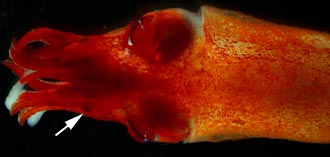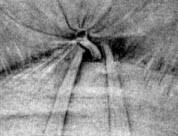Bathyteuthidae
Bathyteuthis
Clyde F. E. Roper- Bathyteuthis abyssicola Hoyle 1885
- Bathyteuthis bacidifera Roper 1968
- Bathyteuthis berryi Roper 1968
Introduction
Squids of the Bathyteuthidae are small, (less than 80 mm ML), compact animals of the deep sea. They have a deep reddish maroon pigmentation, short arms and somewhat tubular eyes directed anteriorly. The fins are small, round and separate. A small photophore is embedded at the base of each of the arms I-III. The Bathyteuthis species occupy the lower mesopelagic to bathypelagic depth zones, and they are scattered throughout the world’s oceans.
Brief diagnosis:
A member of the bathyteuthid families ...
- with buccal connectives attaching to dorsal border of arms IV.
- with small, separate, paddle-like fins.
Characteristics
- Arms
- Arms short, joined by a low, fleshy web.
- Arms I-III with 2 longitudinal series of suckers proximally, increasing to 4 series of irregularly placed suckers distally in adults.
- Buccal connectives attach to dorsal border of arms IV.
- Tentacles
- Tentacular club short, unexpanded, with 8-10 longitudinal series of numerous, minute suckers.
- Tentacular club short, unexpanded, with 8-10 longitudinal series of numerous, minute suckers.
- Head
- Eyes semitubular, anteriorly directed.
- Funnel
- mantle-funnel locking apparatus with a simple, straight ridge and groove.
 Click on an image to view larger version & data in a new window
Click on an image to view larger version & data in a new window

Figure. Left - Ventral view of Funnel locking-aparatus of B. abyssicola from Hawaiian waters. Photograph by R. Young. Right - Locking-apparatus of B. bacidifera. Ventral view of the funnel component on the left and dorsal view of the mantle component on the right. Drawing of from Roper (1968).
- mantle-funnel locking apparatus with a simple, straight ridge and groove.
- Fins
- Fins small, separate, round with anterior and posterior lobes.
- Fins small, separate, round with anterior and posterior lobes.
- Photophores
- Arms I-III with single, simple photophore embedded in subcutaneous aboral tissue at each arm base (see Figure above).
Comments
Species of Bathyteuthis have a peculiar pore just anterior to the funnel that lies between the embedded funnel adductor muscles. This pore leads into a short canal that bifurcates then each branch ends blindly. The function of this structure is unknown.
Nomenclature
Bathyteuthis was erected as a new genus by Hoyle (1885a) for a new species of deep sea squid (B. abyssicola) captured from 2900 m during the CHALLENGER Expedition. It was caught in the Southern Ocean, Indian Ocean segment, between the subantarctic islands of Crozets Island and Prince Edward Island. In the same year Verrill (1885) described a new genus and species, Benthoteuthis megalops, captured the previous year by the ALBATROSS in 1960 m off Martha’s Vineyard, New England.
Neither author designated a family for these new genera. Hoyle (1885b) immediately recognized that Benthoteuthis was a synonym of Bathyteuthis (which had publication priority by 2 months), and he mentioned in 1886 the possibility that the two species might be conspecific. But it was not until 1900 that Pfeffer actually synonymized B. megalops with B. abyssicola when he erected the Family Bathyteuthidae.
The family also contained another unusual genus, Chtenopteryx, which eventually was separated as a subfamily by Grimpe in 1922 and elevated to family Chtenopterygidae by Allen (1945). Two additional species were described in 1968 by Roper: Bathyteuthis bacidifera and Bathyteuthis berryi, and the family was monographed by Roper (1969).
A list of all nominal genera and species in the Bathyteuthidae can be found here. The list includes the current status and type species of all genera, and the current status, type repository and type locality of all species and all pertinent references.
Life History
Presumably all species in the genus brood their young by carrying embryos in an egg sheet held by the arms (Bush, et al., 2012); see also the Bathyteuthis berryi page.
The paralarva is easily recognized by the tentacle and arm IV bases that extend well posterior to the bases of arms I-III (see fig. B below). The position of the digestive gland is well posterior to the cephalic cartilage but it is not visible through the mantle of the preserved paralarva.


Figure. Paralarvae of B. abyssicola, 4 mm ML. Left - A: Ventral view. B : Ventral view of the head and brachial crown with the funnel removed to show how far posteriorly the bases of the tentacles and arms IV lie. The bases of arms I-III lie anterior to the eyes. C: Dorsal view. Drawings of paralarva from Hawaiian waters by R. Young. Bar = 1 mm. Right - Oral view of the branchial crown and tentacular club. Drawings of paralarva from western North Atlantic (from Roper and Sweeney, 1992.
Unusual features
Bathyteuthis spp. have large, orange-colored photosensitive vesicles just posterior to the forward-looking eye. The photosensitive vesicles are extra-ocular photoreceptors that apparently monitor bioluminescent light arising outside of the visual field, including the mantle cavity. In the latter case, small, luminescent organisms inadvertently drawn into the mantle cavity with the respiratory current could reveal the presence of the squid to potential predators in the dark waters of the deep-sea. The photosensitive vesicles of Bathyteuthis are among the largest known in any cephalopod.
References
Allen, J. 1945. Planktonic cephalopod larvae from the eastern Australian coast. Records of the Australian Museum, 21(6): 317-350.
Bush, S. L., H. J. T. Hoving, C. L. Huffard, B. H. Robison and L. D. Zeidberg. 2012. Brooding and sperm storage by the deep-sea squid Bathyteuthis berryi (Cephalopoda: Decapodiformes). Jour. Mar. Biol. Ass. U. K., xx:1-8.
Grimpe, G. 1922. Systematische Ubersicht der europaischen Cephalopoden. Sber. Naturf. Ges. Leipzig, 45-48: 36-52.
Hoyle,W.E. 1885a. Narrative of the Voyage of the Challenger Expedition. The Cephalopoda. Report on the Voyage of HMS Challenger (1873-1876), 1 (1): 269-274.
Hoyle, W.E. 1885b. Preliminary report on the Cephalopoda collected during the cruise of HMS Challenger. The Decapoda. Proceedings of the Royal Society of Edinburgh, 13(120):281-310.
Hoyle, W.E. 1886. Report on the Cephalopoda collected by HMS Challenger during the years 1873-1876. Report on the Voyage of the Challenger, Zoology, 16(44):1-346, 33 pls.
Pfeffer, G. 1900. Synopsis der oegopsiden Cephalopoden. Mitt. Hamburgischen Zoologische Museum.17: 147-198.
Roper, C.F.E. 1968. Preliminary descriptions of two new species of the bathypelagic squid Bathyteuthis (Cephalopoda: Oegopsida). Proceedings of the Biological Society of Washington, 81:261-272.
Roper, C.F.E. 1969. Systematics and zoogeography of the worldwide bathypelagic squid Bathyteuthis (Cephalopoda: Oegopsida). Bulletin of the United States National Museum, 291:1-210.
Roper, C.F.E., and M.J. Sweeney. 1992. Family Bathyteuthidae Pfeffer, 1900. In: Sweeney, M. J., C. F. E. Roper, K. M. Mangold, M. R. Clarke and S. v. Boletzky (eds.) "Larval" and juvenile cephalopods: A manual for their identification. Smithson. Contr. Zool., 513:1-282.
Verrill, A.E. 1885. Third catalog of Mollusca recently added to the fauna of the New England coast and the adjacent parts of the Atlantic, consisting mostly of deep-sea species with notes on others previously recorded. Transactions of the Connecticut Academy, 6(2): 395-452.
About This Page

Smithsonian Institution, Washington, D. C., USA
Page copyright © 2016
All Rights Reserved.
- Content changed 16 November 2016
Citing this page:
Roper, Clyde F. E. 2016. Bathyteuthidae . Bathyteuthis . Version 16 November 2016 (under construction). http://tolweb.org/Bathyteuthis/19429/2016.11.16 in The Tree of Life Web Project, http://tolweb.org/











 Go to quick links
Go to quick search
Go to navigation for this section of the ToL site
Go to detailed links for the ToL site
Go to quick links
Go to quick search
Go to navigation for this section of the ToL site
Go to detailed links for the ToL site